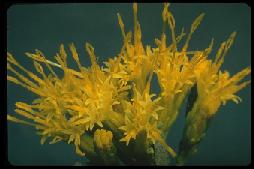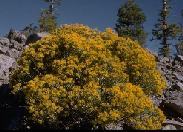
Rabbit-Brush
Chrysothamnus nauseosus (Pursh.) Britt.
var albicaulis Nutt.

Rabbit-Brush
Chrysothamnus nauseosus (Pursh.) Britt.
var albicaulis Nutt.
Rabbitbrush has a deep taproot with less well-developed laterals. Grows about 2-3 feet tall and has a pappus of hairlike bristles
and involucral bracts yellowish and in vertical rows. Woody with
wide-spreading branches covered with matted white wooley hairs. Leaves and stems
are covered with a felt-like layer of trichomes that insulate the plant and
reduce transpiration. Leaves are linear and less than 0.04 inch. Rubber Rabbitbrush
has a deep taproot with less well-developed laterals. Resembles
sagebrush but lacks the strong odor and has narrow, non-lobed leaves.
There are colorful yellow disk flowers in showy clusters with small heads.
A late season plant, first blooming in about mid-July and continuing into
September. Grows on open, dry or sometimes wet places in the valleys, plains,
and foothills, less commonly extending upwards to as much as 3000 in mountain
elevations. Found throughout the Intermountain West. Reported by Nuttall in the
Rocky Mountain plains near the Lewis' River.
Medicinal Uses: A poultice made from the chewed plant tips has been applied to boils and rheumatic joints. An infusion of the leaves has been used to treat coughs, fevers, colds, internal injuries, and constipation. The finely mashed leaves have been inserted in tooth cavities to treat toothache.
Planting: Requires a sunny position and prefers a well-drained sandy soil. Plants do not require a rich soil and they tolerate alkaline soils. A very hardy plant but it prefers a drier climate. Cuttings of half-ripe wood, July/August in sand in a frame.
It exhibits a number of adaptations for surviving in an arid environment. Plants may be "full grown" within 4 years. Rubber rabbit brush establishes from seed and by sprouting. Sprouts originate at or near the soil surface from epicormic buds located on the stem and root crown.
